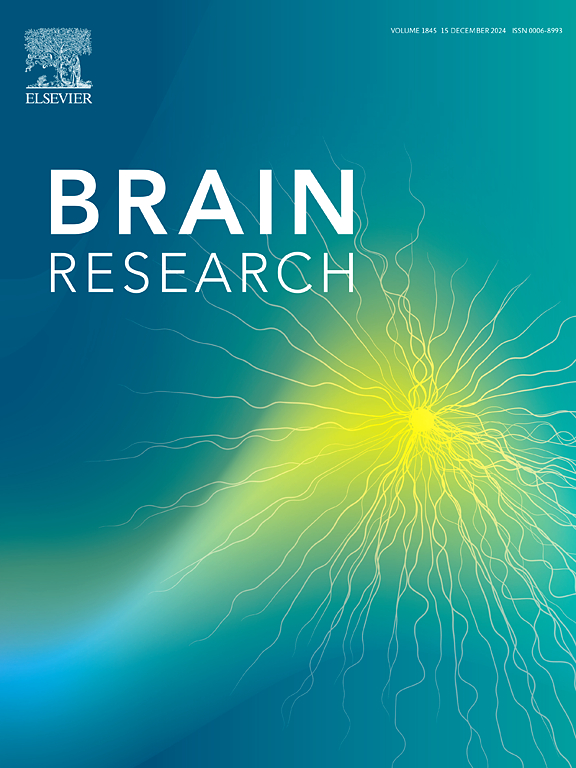黄嘌呤氧化还原酶的非嘌呤抑制剂减轻小鼠大脑缺氧条件下三磷酸腺苷的降解。
IF 2.7
4区 医学
Q3 NEUROSCIENCES
引用次数: 0
摘要
大脑是一个消耗大量氧气的器官,氧气浓度的降低会迅速导致严重的、不可逆转的脑损伤。缺氧时脑损伤的进展涉及细胞内三磷酸腺苷(ATP)的消耗,这是由于线粒体内膜氧化磷酸化的减少。别嘌呤醇是黄嘌呤氧化还原酶的嘌呤类似物抑制剂,可防止缺氧/缺血性脑损伤;然而,其潜在的作用机制尚不清楚。此外,非布司他是一种非嘌呤黄嘌呤氧化还原酶抑制剂,其抑制机制与别嘌呤醇不同。非布司他对脑损伤的影响尚未得到很好的研究。因此,本研究旨在通过局灶微波灭活脑代谢,检测缺氧条件下别嘌呤醇和非布司他存在或不存在时脑ATP及其分解代谢物的水平。低氧处理导致小鼠大脑中腺苷酸能量电荷和ATP水平下降,其分解代谢产物增加。与对照组相比,非布司他组的能量电荷和ATP水平较高,ATP分解产物较低。值得注意的是,尽管两种抑制剂组对尿酸产生的抑制效果相当,但别嘌呤醇治疗的效果不如非布司他。这些结果表明,非布司他能有效地防止缺氧诱导的脑内ATP降解,其作用比别嘌呤醇更有效。本研究将有助于开发改善缺氧引起的脑功能障碍的治疗方法。本文章由计算机程序翻译,如有差异,请以英文原文为准。

A non-purine inhibitor of xanthine oxidoreductase mitigates adenosine triphosphate degradation under hypoxic conditions in mouse brain
The brain is an organ that consumes a substantial amount of oxygen, and a reduction in oxygen concentration can rapidly lead to significant and irreversible brain injury. The progression of brain injury during hypoxia involves the depletion of intracellular adenosine triphosphate (ATP) due to decreased oxidative phosphorylation in the inner mitochondrial membrane. Allopurinol is a purine analog inhibitor of xanthine oxidoreductase that protects against hypoxic/ischemic brain injury; however, its underlying mechanism of action remains unclear. In addition, febuxostat is a non-purine xanthine oxidoreductase inhibitor with a different inhibitory mechanism from allopurinol. The impact of febuxostat on brain injury has not been well investigated. Therefore, this study aimed to examine brain ATP and its catabolite levels in the presence or absence of allopurinol and febuxostat under hypoxic conditions by inactivating brain metabolism using focal microwave irradiation. The hypoxic treatment caused a decrease in the adenylate energy charge and ATP levels and an increase in its catabolic products in mouse brains. The febuxostat group showed higher energy charge and ATP levels and lower ATP catabolites than the control group. Notably, despite the comparable suppression of uric acid production in both inhibitor groups, allopurinol treatment was less effective than febuxostat. These results suggest that febuxostat effectively prevents hypoxia-induced ATP degradation in the brain and that its effect is more potent than allopurinol. This study will contribute to developing therapies for improving hypoxia-induced brain dysfunction.
求助全文
通过发布文献求助,成功后即可免费获取论文全文。
去求助
来源期刊

Brain Research
医学-神经科学
CiteScore
5.90
自引率
3.40%
发文量
268
审稿时长
47 days
期刊介绍:
An international multidisciplinary journal devoted to fundamental research in the brain sciences.
Brain Research publishes papers reporting interdisciplinary investigations of nervous system structure and function that are of general interest to the international community of neuroscientists. As is evident from the journals name, its scope is broad, ranging from cellular and molecular studies through systems neuroscience, cognition and disease. Invited reviews are also published; suggestions for and inquiries about potential reviews are welcomed.
With the appearance of the final issue of the 2011 subscription, Vol. 67/1-2 (24 June 2011), Brain Research Reviews has ceased publication as a distinct journal separate from Brain Research. Review articles accepted for Brain Research are now published in that journal.
 求助内容:
求助内容: 应助结果提醒方式:
应助结果提醒方式:


